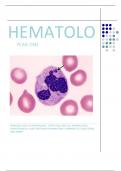Summary
Summary Hematology Study Guide (Year One)
This document contains information that first year hematology students at the college level need to know. It is formatted in a way that is easy to comprehend while not leaving anything out. Topics include basic hematology lab procedures, cell morphology, hematopoiesis, diseases relevant to hematolo...
[Show more]



